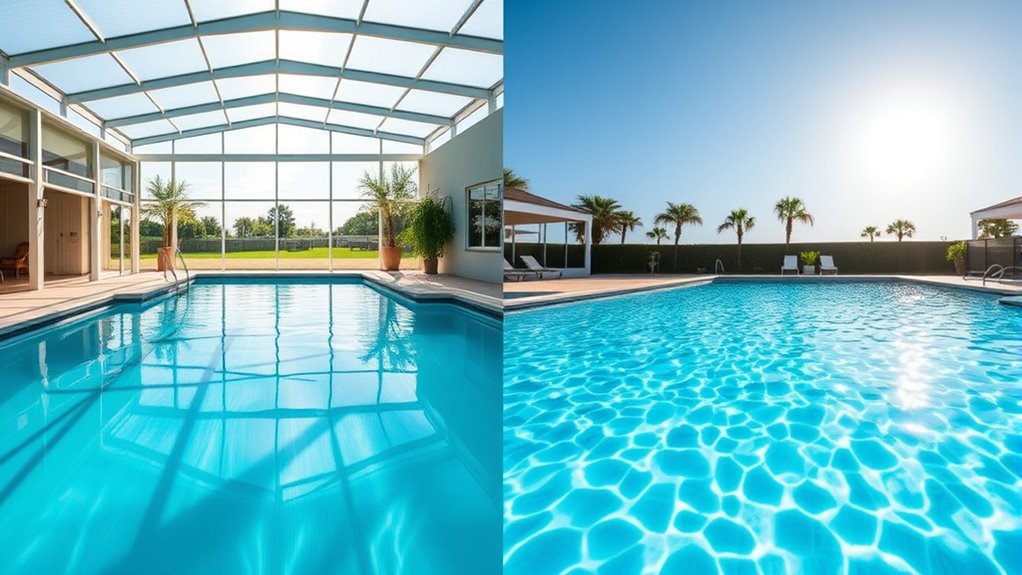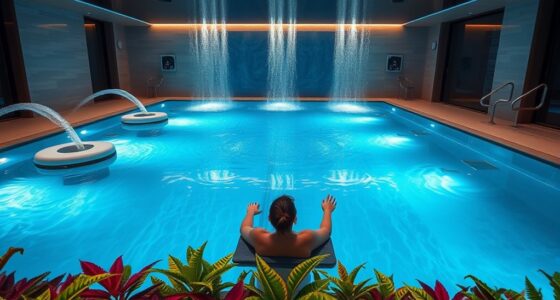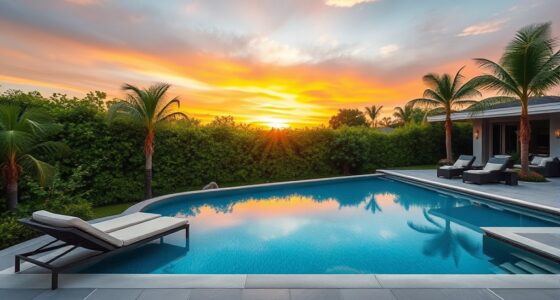Outdoor pools get more UV exposure, which speeds up chlorine breakdown and raises maintenance costs. You’ll need to add chemicals more often and deal with algae and debris. Indoor endless pools stay protected from sunlight, keeping chemical levels stable and maintenance lower. If you want to minimize ongoing expenses and keep your pool cleaner, understanding the full comparison can help you make the right choice for your needs.
Key Takeaways
- Outdoor pools are exposed to direct sunlight, increasing UV-related chlorine degradation and chemical costs.
- Indoor endless pools benefit from minimal UV exposure, resulting in more stable chlorine levels.
- UV exposure in outdoor pools accelerates algae growth and debris accumulation, demanding more cleaning.
- Indoor pools have lower ongoing chemical and maintenance costs due to reduced UV impact.
- UV exposure affects energy efficiency, with indoor pools benefiting from consistent climate control and less weather-related wear.

When choosing between an endless pool and an outdoor pool, you need to contemplate your space, budget, and lifestyle. One of the key factors to consider is how each type handles UV exposure, which directly impacts chlorine levels, maintenance costs, and overall pool care. An outdoor pool is constantly exposed to the sun’s rays, leading to faster chlorine degradation. Sunlight breaks down chlorine, which means you’ll need to add more frequently to keep the water sanitized. This increased chemical use raises your maintenance costs over time, as you spend more on chlorine and other water treatment supplies. Additionally, prolonged UV exposure can encourage algae growth, requiring additional chemicals and effort to keep the pool clean and safe.
Outdoor pools face faster chlorine loss due to UV exposure, increasing maintenance and chemical costs over time.
In contrast, an endless pool, typically installed indoors or in shaded areas, offers significant protection from direct sunlight. This reduced UV exposure helps maintain more stable chlorine levels, meaning you won’t need to add chemicals as often. Consequently, your maintenance costs decrease because you’re not constantly battling the sun’s effects on your pool’s chemistry. With less chemical fluctuation, you also reduce the risk of corrosion or damage to equipment caused by excessive chemical adjustments. Indoor endless pools are less affected by environmental factors like debris, leaves, or insects, which can further reduce the need for frequent cleaning and chemical balancing. Moreover, because UV exposure impacts the efficiency of the refrigeration cycle in heat pumps, indoor pools can also benefit from more consistent climate control and energy efficiency.
However, it’s essential to remember that indoor pools might have higher initial installation costs, especially if you need to build or convert a space for indoor use. While the ongoing maintenance costs could be lower due to minimized UV exposure, you should also consider the energy costs associated with heating and ventilating an indoor space. Conversely, outdoor pools generally have lower upfront costs but can incur higher ongoing expenses related to chemical treatments, cleaning, and repairs caused by sun damage or weather-related wear and tear.
Ultimately, your choice depends on your willingness to manage chemical levels and your budget for ongoing upkeep. If you prefer a low-maintenance setup with stable chlorine levels and fewer chemical adjustments, an indoor endless pool is likely the better option. On the other hand, if you’re comfortable with regular chemical treatments and don’t mind the extra effort to maintain water quality in the sun, an outdoor pool could suit your needs. Remember, UV exposure plays a significant role in how much effort and expense you’ll need to invest in maintaining your pool’s clarity and safety over time.
Frequently Asked Questions
How Does UV Exposure Vary With Pool Size?
Your UV exposure varies with pool size because larger pools allow deeper UV penetration, increasing your risk of overexposure. Smaller pools, like endless pools, limit UV penetration to the surface, reducing risk. When you swim in larger outdoor pools, you’re more exposed to UV rays because sunlight can penetrate deeper. So, always protect yourself with sunscreen or shade, especially in bigger pools where UV penetration is greater.
Are There Health Risks Linked to UV Exposure in Pools?
UV exposure in pools can pose serious health risks, including skin cancer and eye damage, if you’re not careful. The sun’s rays are stronger than a thousand suns at peak hours, making it essential to wear protective gear and limit your time in direct sunlight. Long-term exposure increases your risk of skin cancer and eye damage, so always prioritize sun safety to enjoy your swim without harmful consequences.
Can Pool Covers Reduce UV Exposure Effectively?
Yes, pool covers can effectively reduce your UV exposure. Using pool cover types made from UV resistant materials offers the best protection, as these are designed to block harmful UV rays. When you cover your pool, especially during off-hours, it minimizes direct sun exposure and helps prevent skin damage. Opt for high-quality, UV-resistant covers to guarantee maximum safety and safeguard your skin from harmful UV rays while you enjoy your pool.
Do Outdoor Pools Require Special UV Protection?
Yes, outdoor pools require special UV protection because prolonged exposure to sunlight can raise your pool temperature and reduce water clarity. You should use UV-resistant covers, apply appropriate sunscreen, and consider installing shading options like umbrellas or pergolas. These measures help maintain water quality, keep the pool cooler, and protect your skin from harmful UV rays during extended outdoor swims. Proper protection enhances your overall swimming experience and safety.
How Does Chlorine Level Impact UV Exposure Risks?
Think of chlorine as your pool’s shield—when levels are properly maintained, it helps reduce UV risks by destroying harmful microorganisms, much like a knight’s armor. However, if chlorine safety drops, your skin and eyes become more vulnerable to UV damage. Proper UV filtration works best alongside balanced chlorine levels, ensuring you’re protected while enjoying your swim. Keep an eye on chlorine to stay safe and sun-smart.
Conclusion
When choosing between an endless pool and an outdoor pool, consider your UV exposure and how often you’ll swim. Did you know that outdoor pools can expose you to up to 80% more UV rays than indoor or endless pools? If sun protection is a priority, an endless pool offers a safer, more controlled environment. Ultimately, weighing these factors helps you decide which pool type fits your lifestyle and keeps you enjoying your swim safely.









